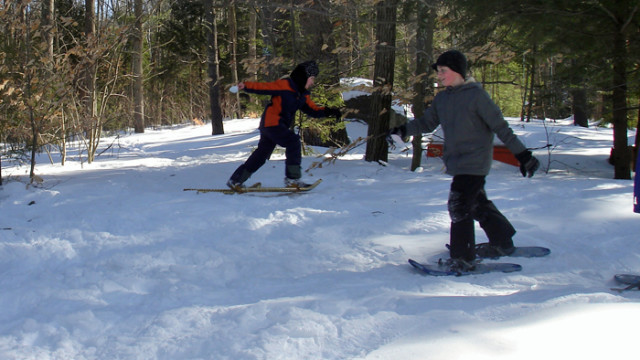Winter is definitely for KIDS! There is something about snow that brings out the inner-child. The sight of huge snow banks and snow-covered hills seems to beckon children of all ages to play and slide, and some to even launch themselves off the top knowing the landing will be soft.
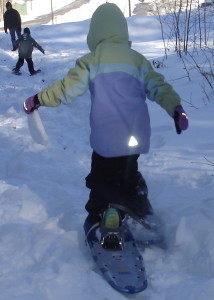
Actually, winter is enticing not only for kids. My students and colleagues at New England College in Henniker, New Hampshire (where I run the outdoors program) have been checking snowshoes out of the equipment closet every day this winter.
Snowshoe Games For Kids
Recently, two of my students and I had the joy of taking a group of children to the woods to play on snowshoes. It was a cold day, but the sun was shining. Presidents’ Week vacation was coming to an end, and local daycares and vacation camps had done a great job of entertaining children, but these kids were more than ready for an opportunity to just get outdoors and “play.”
As we eagerly waited for the bus full of children to arrive, we aligned 18 pairs of snowshoes and stood in the sun. We heard the rumble of the bus as it pulled up. The doors opened and within seconds the three of us were bombarded with yells from energetic little puffballs. I couldn’t even make out their faces beneath the hats and hoods.
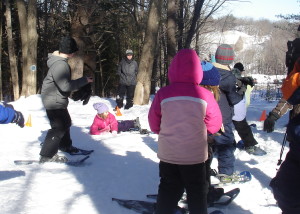
The excitement level was high, and the smiles never left our faces, let alone theirs. Once the snowshoes were on we all tromped through the snow and into the woods.
Clearly, just hiking was not going to be enough to stave off boredom and expend the energy these little guys needed to burn to keep warm.
With a group of 18 kids, games were in order. We played a series of non-competitive games usually played in gyms or open fields. As an outdoor educator, I have played team games, tag games, and scavenger hunts with children on snowshoes. In fact, almost any game can be played on snowshoes. Playing them on snowshoes adds an element of silliness, especially when the snowshoes are sized for adults!
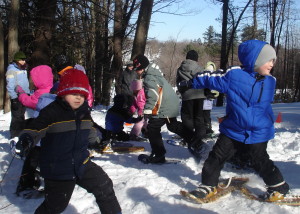
For a full hour and a half our “students” were laughing, falling, and playing in the snow on snowshoes. One of the games we played involves pretending to be birds. The object is to protect nests, gather food for survival, and keep the blue jays away. As the children tromped through the snow to find places to hide their nests, you could almost hear their smiles. A look in the distance showed students exploring the woods as they contemplated the strategy of their nest hiding.
The Blue Jays (two children deemed “it”) began counting loudly to 25 with their eyes closed and couldn’t stop laughing. The shout of “TWENTY-FIVE!” brought 16 juncos (the rest of the children) running to the feeders (adults holding bags of beans) to get food to bring back to their hidden nests.
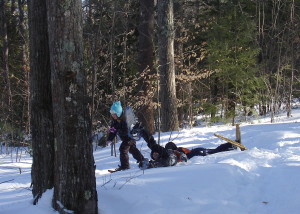
When it came time to end our day on snowshoes, all we heard were grumbles and moans. The children were reluctant to leave and go back inside on a cold day. They wanted to play more games and explore the woods. As we walked down the trail to where the bus was parked they talked of where to hide nests next time, if they could jump off the top of the hill, challenges of who could walk backwards, and some asking their parents for their own pair of snowshoes.
Playing with children outside, even in the cold, can bring out the inner-child in all of us. Don’t let winter keep you trapped indoors. Get outside! Dress properly with warm layers and no cotton. Keep the activity level high, and the fun level up in the clouds. Snacks and water are also key components to having fun.
Snowshoe Games For Kids: Jays and Juncos
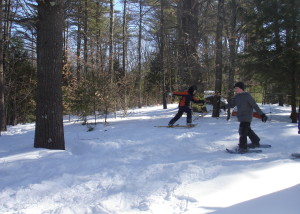
The game our group played is called “Jays and Juncos,” and it keeps kids moving, thinking and exploring.
Here are the rules:
Everyone gets a nest (bowls or cups work well.)
The object is to get as much food as possible to feed their babies. At the end of the game ( a predetermined time) each 4 beans equals 1 baby bird.
One or more players are designated Blue Jays (1 Jay for every 8 Juncos). They steal seeds from the nests
The Blue Jay counts to “25” while the Juncos hide their nests.
At 25 ,the Juncos run to the feeder (a person holding a bag of beans.)
The Juncos each receive 5 beans (food) to bring back to their nest.
The Blue Jays try to find nest and steal the food, A Jay can only take 3 beans at a time and may not return to the same nest consecutively.
The Juncos run to and from their nest collecting food from the feeder.
The children can use different strategies to hide their nest and get as much food as possible. For example, hiding a nest farther away is safe from Blue Jays, but makes it hard to get food; hiding a nest closer may allow a Blue Jay to find the nest more easily, but also allows the Junco to continually retrieve more beans from the feeder.
When the game ends, some children may need help with math to figure out how many babies they have.
Everyone wins!


